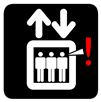 When you’re a creative type, you usually find yourself with far more ideas than you have the time or resources to develop. This blog is filled with stuff like that, not only elevator pitches for films and television shows, but also: a more expansive National Zoo; an archaism park for Renaissance Faire enthusiasts, steampunkers, and historical reenactors; a Jazz Age-themed site; an improved DC Metro system; and an improved nationwide rail system. Not currently having the means to accomplish these dreams doesn’t mean you shouldn’t dream! It keeps the neurons in good health.
When you’re a creative type, you usually find yourself with far more ideas than you have the time or resources to develop. This blog is filled with stuff like that, not only elevator pitches for films and television shows, but also: a more expansive National Zoo; an archaism park for Renaissance Faire enthusiasts, steampunkers, and historical reenactors; a Jazz Age-themed site; an improved DC Metro system; and an improved nationwide rail system. Not currently having the means to accomplish these dreams doesn’t mean you shouldn’t dream! It keeps the neurons in good health.
So, when I recently had an intriguing idea for a video game, I decided to flesh it out a bit für Scheiße und Kichern. And, I hope the folks who own the images I use understand I’m just proposing something that could make them lots and lots of moolah. Forgive me. And, if you’re reading this, considering those images ads and go buy some classic music.
PLAY THAT TRIPPY MUSIC
I am not a big player of Kingdom Hearts, but I’m super-impressed with the concept of a crossover game where different pop culture characters and settings exist in the same game world. The same goes for Guitar Hero, which I’ve played a bit more than Kingdom Hearts. The nostalgia dynamic of “playing” popular songs is viscerally attractive.
I would love to fund and lead the development of a game that mashes up these two concepts by presenting a world based on trippy album cover art from the 1970s and early 1980s. The album covers from this era are often quite evocative of a game setting and the characters on them vividly suggest bosses to defeat.
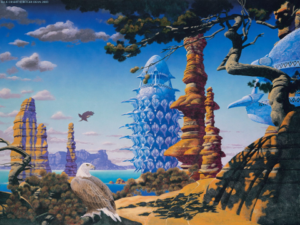 Let me go through the basic ideas of Tripworld, a sandbox RPG where players explore a world based on classic album cover art and encounter threats with theme music from the bands whose albums they come from. Yes, this would require the acquisition of a mountain of intellectual property licensing, but the royalties would almost certainly make it worth it.
Let me go through the basic ideas of Tripworld, a sandbox RPG where players explore a world based on classic album cover art and encounter threats with theme music from the bands whose albums they come from. Yes, this would require the acquisition of a mountain of intellectual property licensing, but the royalties would almost certainly make it worth it.
I was initially inspired by the art of Roger Dean, who painted iconic covers for bands like Yes, Uriah Heep, and Asia. Check out an example of his work at the right.
Dean’s imaginary world is a place of winding trees, weird rock formations, floating islands, waterfalls, odd fantasy creatures, and magnificently improbable buildings. Exploring this setting, just for the joy of taking in the landscape, would alone be a major draw for gamers.
Of course, in the Tripworld cross-over I’m imagining, there would also be places based on other album cover art, like that of Earth, Wind, and Fire (which I will call EWF below to avoid problems with the commas). Having specific sites that recreate specific classic rock covers would be a major draw of the game; in fact, locating these sites could unlock achievements and songs.
I’ll go into this in more detail later.
WHAT IS TRIPWORLD?
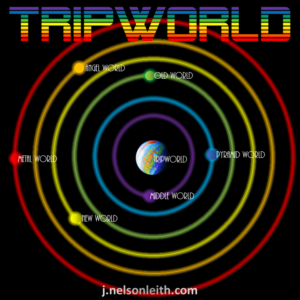 The way I would incorporate this artistic diversity into the game would be to have the setting be a region of space centered on a gas giant called Tripworld, a ball of swirling psychedelic colors.
The way I would incorporate this artistic diversity into the game would be to have the setting be a region of space centered on a gas giant called Tripworld, a ball of swirling psychedelic colors.
Around this giant planet would orbit six terrestrial worlds for the player to travel between, having various adventures. Tripworld itself would only be for anchoring the game and looking pretty in the sky.
Each of these six playable worlds would exemplify a different style of classic rock album art and would be on different orbits defined by color: purple, blue, green, yellow, orange and red.
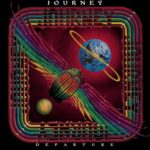 The player would enter the game and move between settings using a vehicle based on the iconic rainbow-winged ship of Journey albums, which would be called Scarab. Scarab could feature an NPC henchman, perhaps the embodiment of the ship’s AI, based on the android on the Frontiers cover. The band’s early music (up to Frontiers) could play whenever the player is inside Scarab in interplanetary space, based on what was going on.
The player would enter the game and move between settings using a vehicle based on the iconic rainbow-winged ship of Journey albums, which would be called Scarab. Scarab could feature an NPC henchman, perhaps the embodiment of the ship’s AI, based on the android on the Frontiers cover. The band’s early music (up to Frontiers) could play whenever the player is inside Scarab in interplanetary space, based on what was going on.
In a massive space battle? Edge of the Blade kicks off.
So, the core dynamic of the game would be traveling from world to world in Scarab, performing missions in order to gather coins to buy equipment (or win special items in side quests) which helps defeat the bosses.
These missions (and the equipment purchases) will take the player throughout the Tripworld system, slowly familiarizing them with each world as they advance through the story.
CURRENCY
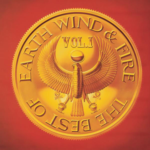 The coinage of Tripworld is based on the cover art of the Best of Earth, Wind, and Fire album, perhaps with the “volume” text removed and the circling text merely reading “Earth, Wind, and Fire.” Whenever the player earns coins by completing missions, the band’s music could play as an added reward.
The coinage of Tripworld is based on the cover art of the Best of Earth, Wind, and Fire album, perhaps with the “volume” text removed and the circling text merely reading “Earth, Wind, and Fire.” Whenever the player earns coins by completing missions, the band’s music could play as an added reward.
The cover art of EWF often features pyramids and other Egyptian imagery, very similar to Asia cover art. This imagery could be the basis of one of the game’s worlds, specifically the one where most of the general equipment can be purchased with the EWF coins.
You’ll see. Let’s get into the worlds and their bosses.
THE SIX WORLDS
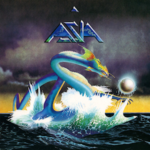 The Pyramid World of Asia and EWF covers would be filled with grand statuary and vibrant merchant cities along a winding rivers.
The Pyramid World of Asia and EWF covers would be filled with grand statuary and vibrant merchant cities along a winding rivers.
And, of course, pyramids everywhere.
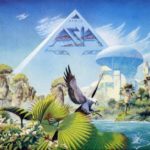 The boss of the world, a blue water dragon from the cover of Asia’s debut album (left), could be heralded by the song “Time Again” from that album.
The boss of the world, a blue water dragon from the cover of Asia’s debut album (left), could be heralded by the song “Time Again” from that album.
Considering how often the player will have to visit this world for equipment, the blue dragon boss could be the first boss that must be defeated to move forward in the story. The red dragon from XXX (left), although late in the band’s career, could be a follow-up boss on Pyramid World.
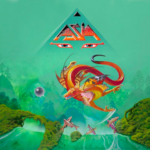 Pyramid World would be in Tripworld’s “blue orbit,” the second orbit out from the gas giant.
Pyramid World would be in Tripworld’s “blue orbit,” the second orbit out from the gas giant.
Beyond the cover art of EWF, any classic rock cover that portrays archaic architecture, mythical creatures, and fantastical landscapes could fit into Pyramid World.
As the place where the player goes for personal equipment, this will be a sort of “homebase” for the game, which is fitting since this style of classic rock cover art is core to the concept.
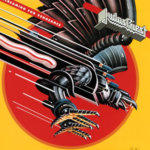 The Metal World would be filled with mechanical NPC’s, dieselpunk cities, and robot monsters. And, obviously, lots of classic metal music.
The Metal World would be filled with mechanical NPC’s, dieselpunk cities, and robot monsters. And, obviously, lots of classic metal music.
The big bosses of this world would clearly be the mechanical lion from Judas Priest’s Defenders of the Faith cover, followed by the mechanical eagle from Judas Priest’s Screaming for Vengeance cover (right), which would swoop down at random, harassing the player with metal music playing in the background.
The equipment purchased here would include repairs and improvements to the Scarab. The settlements here would be less prosperous and majestic than on Pyramid World, more gritty and hard-boiled (imagine Mad Max meets film noir), but would have more opportunities for the player to engage in black market deals.
Metal World would be in Tripworld’s “red orbit,” the outermost orbit from the gas giant.
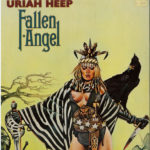 The Angel World would be an idealized, Afro-European fantasy setting based on the Uriah Heep Fallen Angel album cover (left), which features a female warrior draped in zebra skin.
The Angel World would be an idealized, Afro-European fantasy setting based on the Uriah Heep Fallen Angel album cover (left), which features a female warrior draped in zebra skin.
This is an eclectic world where the player wanders through a savannah dotted by settlements with an odd mix of Medieval Europe and Iron Age Africa.
The big boss of this world would be the woman from the album cover, whose appearance would be heralded by the song “Woman of the Night” from that album.
The draw of this world would be discovering the Toto Sword (described below) as a powerful weapon against future bosses.
Angel World would be in Tripworld’s fifth, “orange” orbit.
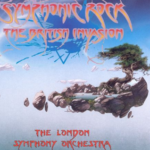 The Middle World would be based on the trippiest artwork of Roger Dean, an example of which you can see at right from the Symphonic Rock : The British Invasion album.
The Middle World would be based on the trippiest artwork of Roger Dean, an example of which you can see at right from the Symphonic Rock : The British Invasion album.
Imagine floating rocks, twisted trees, pools and waterfalls, populated primarily by fantastical creatures.
In this world there are no settlements and the player discovers equipment by following clues uncovered during missions in other worlds. This adds an intriguing element to the general grind of the story.
There is no boss in this world, making it a unique setting in the game where the focus is on exploration.
Middle World would be the world closest to Tripworld, in the innermost, “purple” orbit.
 The Old World is based on the Dark Ages imagery of covers like Molly Hatchet’s debut album (left). This is a gothic world of Dark Ages civilization, with wizards, dragons, ghouls, and other dark fantasy beasts.
The Old World is based on the Dark Ages imagery of covers like Molly Hatchet’s debut album (left). This is a gothic world of Dark Ages civilization, with wizards, dragons, ghouls, and other dark fantasy beasts.
Imagine gloomy forests, rocky hills, cloud cover, and snowfall. Sharp contrasts of light and dark. Where Roger Dean’s sensibilities might rule Pyramid and Middle Worlds, Old World is solidly Frank Frazetta and Boris Vallejo.
The big boss for this world is the horse-riding, axe-wielding warrior from the image at left. When confronting this boss, “Flirtin’ with Disaster” (even though it’s from a different album) would play.
The Old World rides the third, “green” orbit of Tripworld.
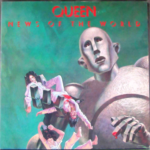 The New World is a futuristic pseudo-utopia of technology. While Metal World is a gritty world of machines still interacting with humans in a dynamic way, New World is more of a clean vision of the Robot Future where machines rule.
The New World is a futuristic pseudo-utopia of technology. While Metal World is a gritty world of machines still interacting with humans in a dynamic way, New World is more of a clean vision of the Robot Future where machines rule.
The first boss of New World is the giant robot from Queen’s News of the World cover (right). When this foe appears, Queen’s “Sheer Heart Attack” plays and is unlocked.
New World is where the player can acquire highly advanced technologies, if the advanced local technology can be overcome.
New World is in the fourth, “yellow” orbit of Tripworld.
SPECIAL ITEMS, SITES, AND NPCs
1984. This NPC, based on the cherub from the eponymous Van Halen cover, features in player missions based on New World. Fulfilling 1984’s mission unlocks the songs “Panama” and “Jump.”
5150. This NPC, based on the Atlas figure from the eponymous Van Halen cover, also features in player mission based on New World. Fulfilling 5150’s mission unlocks the songs “Why Can’t This Be Love” and “Dreams.”
Afterburner. This vehicle, based on ZZ Top covers, would first be encountered as a ground vehicle (called Eliminator) on Metal World and later as a space vehicle in its full Afterburner incarnation.
Ammonia Avenue. A street in a neighborhood on Metal World, with a central feature based on the eponymous Alan Parsons Project cover.
Animals. An industrial neighborhood on Metal World, based on the eponymous Pink Floyd cover. Flying pigs haunt this area.
Aqua. The flying dolphin from the eponymous Asia album could feature as a creature on Middle World.
Astra. The figure from the eponymous Asia album could be a recurring NPC from Pyramid World who aids the player on certain missions.
Blue Ship. The UFO that appears on multiple ELO covers.
Boston. The iconic UFO from Boston albums, which launches from a huge mothership called Third Stage, based on the spaceship on Boston’s Third Stage cover.
The Buyer. The skeletal character from Megadeth’s Peace Sells … But Who’s Buying? cover would be an NPC on Metal World who deals in illicit weapons.
Daylight. A mountain retreat on Pyramid World, based on the Crosby, Stills, and Nash Daylight Again cover. In order to use it as a base, the player would have to defeat the three UFOs on the cover.
Demon Wizard. An NPC magic merchant on Middle World based on the figure in Uriah Heep’s Demons and Wizards cover.
Eye in the Sky. A satellite of Pyramid World, a sphere of stone marked by the Egyptian sigil from the eponymous Alan Parsons Project cover.
Father Kansas. The bearded character on various Kansas covers would be an NPC on Dark World, perhaps a secondary boss.
Friendly Card Chapel. A site on Angel World based on the cover of the Alan Parsons Project’s The Turn of a Friendly Card cover.
High and Mighty. A space ship based on the eponymous Uriah Heep cover.
I Robot. The figure on the eponymous Alan Parsons Project cover is an NPC on New World, perhaps a secondary boss.
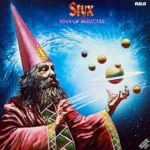 Man of Miracles. From the eponymous Styx cover (right), this NPC on Old World recreates the album cover (but with the Tripworld system replacing the original planets) while providing key clues to the player’s storyline.
Man of Miracles. From the eponymous Styx cover (right), this NPC on Old World recreates the album cover (but with the Tripworld system replacing the original planets) while providing key clues to the player’s storyline.
Monolith. The space helmet-wearing Native American from Kansas’s Monolith cover would live on Metal World. He could provide clues to the location of the Skull of the Limit (see below).
The Moon. A prism-shaped satellite of Pyramid World based on Pink Floyd’s famous Dark Side of the Moon cover, which projects a rainbow onto the surface of the world as it passes between Pyramid World and the Sun. When the player is in this rainbow, music from the eponymous album plays.
The Noize. An NPC on Metal World, based on the figure in Quiet Riot’s Metal Health cover.
The Out Door. A bar in the Metal World based on Led Zeppelin’s In Through the Out Door cover. The player can obtain side missions here.
Physical Graffiti. A neighborhood on Metal World based on the eponymous Led Zepellin cover.
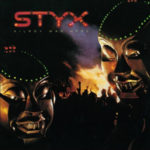 Mr. Roboto. From the Styx Kilroy Was Here cover (left), this NPC would be a secondary boss on New World.
Mr. Roboto. From the Styx Kilroy Was Here cover (left), this NPC would be a secondary boss on New World.
Paradise Theater. From the eponymous Styx cover, this site on Metal World would be a place for the player to seek clues to missions.
Salty Dog. An NPC on Pyramid World who helps the player cross seas, based on the eponymous Procol Harum cover.
Skull of the Limit. Found on Old World, this decorated skull from the One of These Nights cover, once installed in Scarab, buffs the ship to maximum speed, maneuverability, firepower, and shields.
Spitfire. A dragon based on the eponymous Jefferson Starship cover, this monster lives on Middle World.
Tarkus. A boss on Middle World based on the armadillo monster from the eponymous Emerson, Lake, and Palmer cover.
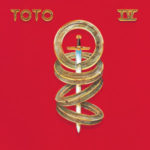 Toto Swords. These discoverable swords (based on the Toto cover theme, as in IV at right) on Angel World are powerful weapons that the player can wield against bosses. Toto I and Toto IV are generically magical swords useful against all enemies. Toto II is specifically enchanted to slay a boss known as the Hydra (as that is the title of the second Toto album). Toto IV is just a sigil (see the Turn Back cover) that turns Toto II back into a generically magical sword, slightly more powerful than Toto I. Another sigil transforms Toto IV into an even more powerful weapon, and bringing it to a special location on Metal World buffs it once again. The final upgrade is Toto VII.
Toto Swords. These discoverable swords (based on the Toto cover theme, as in IV at right) on Angel World are powerful weapons that the player can wield against bosses. Toto I and Toto IV are generically magical swords useful against all enemies. Toto II is specifically enchanted to slay a boss known as the Hydra (as that is the title of the second Toto album). Toto IV is just a sigil (see the Turn Back cover) that turns Toto II back into a generically magical sword, slightly more powerful than Toto I. Another sigil transforms Toto IV into an even more powerful weapon, and bringing it to a special location on Metal World buffs it once again. The final upgrade is Toto VII.
Ultimate Sin. Based on the woman on the eponymous Ozzy Osbourne cover, she is an NPC on Old World with a monstrous henchman based on the Ozzy-based creature on the same cover. She represents a secondary boss on that world.
Wise Man. An NPC on Middle World based on the eponymous song from Uriah Heep’s Firefly cover. Firefly is the magical bird that Wise Man rides, based on the bird on the cover.
Zoso. An NPC in Old World based on the figure on the Zepellin IV cover. Honoring the band’s insistence that the symbol interpreted as “Zoso” was never intended to represent those Latin alphabet letters, the NPC would insist he has no name.
